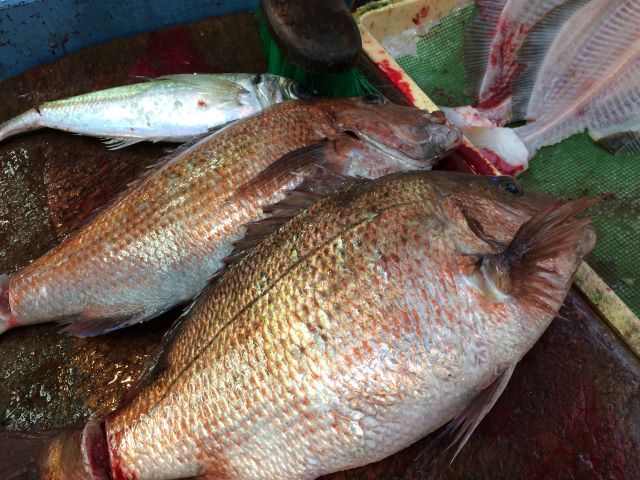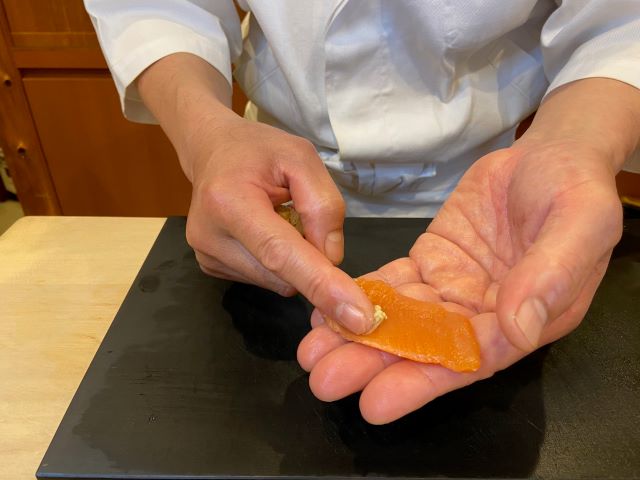
Articles related to Sushi are now filled with jargon such as Shinkeijime, Chinuki, Noujime, Ikekoshi, and Korijime. That much confirms the fact that opportunities to eat fish are increasing all over the world. And it has also become a common occurrence to find articles written by people who have heard Ikejime in bits and pieces. According to what we have heard, Ikejime processing is one of the reasons why red seabream from Akashi, which is said to be the best in Japan, is so tasty, and the technology has been around since the Edo period (1603-1868).
The Ikejime procedure consists of four parts or some of them, and the point of Ikejime is to kill the fish in a relaxed state.
The first step is a brain-dead the fish by stabbing it in the head with a sharp object. This process is called Noujime (Nou means brain and jime means kill).
After the fish is out of the water and before it gets out of control, it is stabbed in the head with a hook called a Tegaki (手鉤). If the brain is not destroyed by one blow, the fish will struggle. When this happens, a large amount of ATP, which is the source of umami, is consumed. As a point of caution, the right side of the head is stabbed so that the puncture wound is not on the upper side, as the fish will be handled later in the distribution process with the belly facing forward and the head facing to the left.
Next, use a knife to quickly kill the live fish.
Place the fish with its head facing left, open the gill cover, and cut a spinal cord below the lateral line that is visible on the fish’s body. Since bones have hard parts, move the cutting edge slightly to the left and right if it is difficult to cut. If you don’t cut it completely, you have not killed the fish, and the blood will not drain well. To drain the blood sufficiently, the spinal cord at the base of the tail is also cut off. Place the fish’s head to the right and cut the front part of the tail so that the spinal cord is visible. At this point, the knife should be placed at a right angle to the spinal cord so that the cut surface is not at an angle.
The next step is to remove the nerves and delay rigor mortis. This process is called Shinkeijime (Shinkei means nerve).
Shinkeijime is a technique to delay rigor mortis in fish. A wire is inserted into a small hole in the upper part of the spinal cord. When the wire hits the nerve, the fish will act violently, so hold it down. The nerve hole tapers from the head side to the tail, so when stabbing in from the tail side, make sure to insert the wire securely first, so that the wire does not pierce through the nerve hole and pierce the body. Once you have securely inserted the wire, repeatedly pull out and insert the wire to completely destroy the nerve in the hole. When the nerve is destroyed, the body color quickly changes to white. The destroyed nerve appears as a white, sludgy fluid.
Any wire can be used for this purpose as long as it is straight, but a piano wire that does not bend easily can be used many times. The diameter of the nerve hole differs depending on the fish. Use a thick wire for Tai and Suzuki, which have large nerve holes, and a thin wire for Aji and Anago, which have small nerve holes. Several types between 0.8mm and 1.5mm should be enough. As you get used to it, you will be able to stick the wire in without visually seeing the nerve hole. If you remove a few scales from the upper part in front of the tail, insert the wire along the spinal cord, probe the nerve hole, pierce it, and destroy it, you can remove the nerve without making any cuts on the fish’s body. The same applies to the head side. The nerve hole is probed and pierced from the head side, but the key is to keep the head and body straight so that the nerve hole is not misaligned by the spinal cord severed behind the gills. In any case, it takes experience and familiarity to pierce the nerve hole without seeing it.
The final step is to perfectly remove the blood from the fish’s body. In Japanese, it is called Chinuki (Chi means blood and nuki means remove).
The blood is removed by cutting the spinal cord and immersing the fish’s body in seawater. At this time, running water is more reliable to remove blood. In the case of stored water, leave it for a while and then replace it with other stored water. If the water does not turn red with blood, the fish has already been drained. Blood has a tendency to clot, so it is important to wash off any blood that has clotted on the gills or other parts of the body. The body temperature of the fish is raised by the Ikejime process and by human hands. Since the fish were originally in the sea, which has a lower temperature range than that of the ground, the higher temperature increases the speed of deterioration, so the fish is soaked in ice water to lower the temperature of the fish’s body. If the fish is soaked too long, its body surface will turn white, so remove it from the water when it cools down.
[sc_apply url=”https://sushiuniversity.jp/apply/”]
We hope this information will be helpful.

Revision date: August 18, 2023
Share this article
